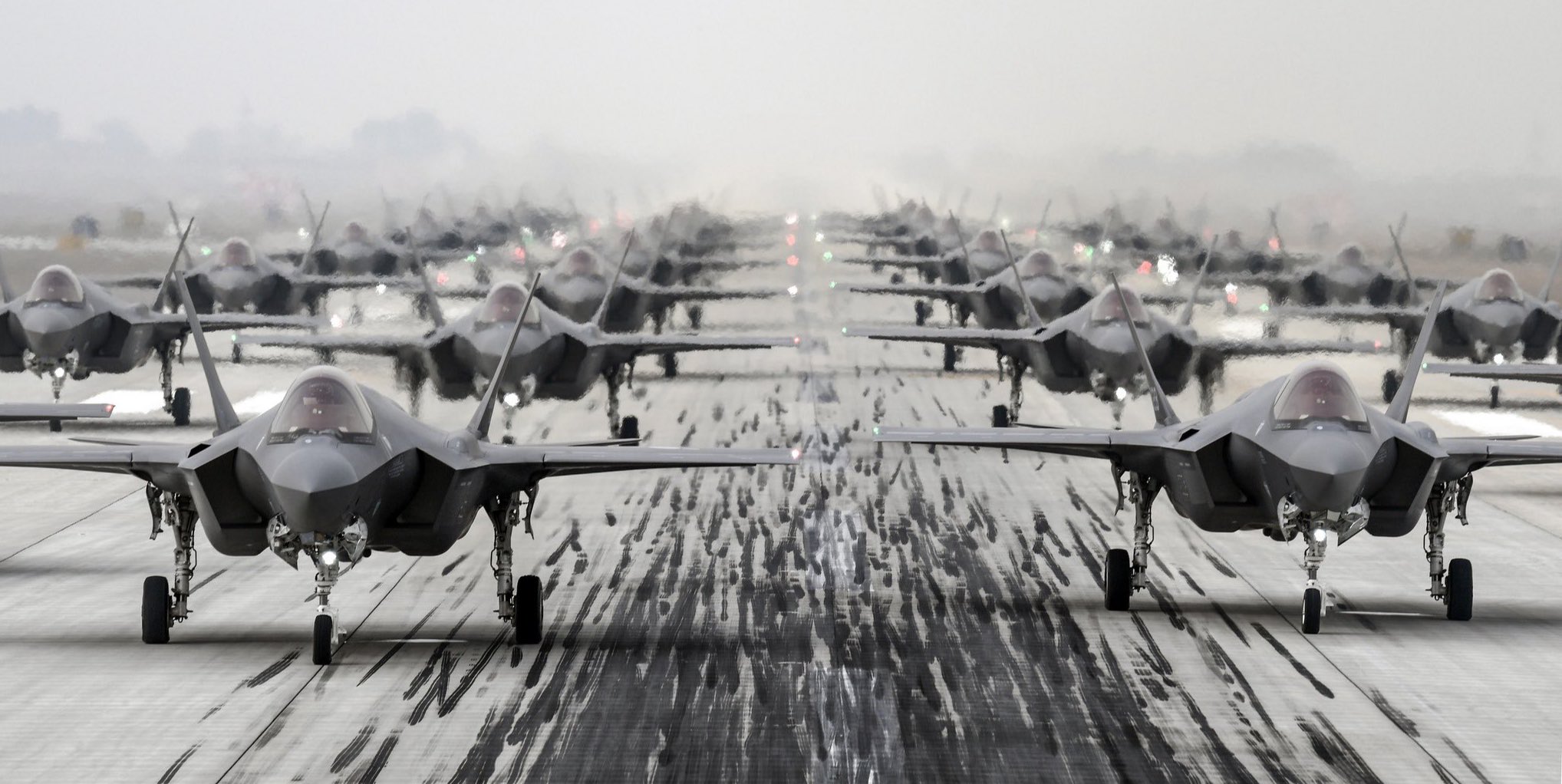The day after North Korean leader Kim Jong-un supervised artillery firing drills involving border troops capable of striking Seoul, the South Korean Air Force organized an “elephant walk” at an air facility just south of Seoul.
On March 8, 33 aircraft, including F-35A stealth fighters, KF-16s, F-15Ks, and F-4Es, demonstrated South Korea’s air power at the Suwon air base.
The event was part of the annual Freedom Shield exercise, which South Korea and the US have been conducting since earlier this week to bolster deterrence against North Korea’s nuclear and missile threats.
“As the elephant walk training demonstrated today, (we) must become an Air Force that instills trust in the people and fears in the enemy, with capabilities and a posture to overwhelmingly respond to any enemy provocation,” Air Force Chief of Staff Gen. Lee Young-su was quoted as saying at the exercise.
The fully-armed jets taxied in formation around an airfield during the ‘Elephant Walk’ training to rehearse routine pre-takeoff procedures and assess their preparedness.
‘Elephant Walk’ is a USAF term initially used during World War II to describe the process of preparing fighter aircraft for taxiing either immediately before takeoff or immediately after landing. It is typically employed as a strategy to demonstrate military prowess and deterrence.
Notably, the latest ‘Elephant Walk’ was conducted one day after North Korean leader Kim Jong-un guided an artillery firing drill by the Korean People’s Army.
The exercise, which took place on March 7, involved border-region units within fire range of “the enemy’s capital.” According to KCNA, the exercise “fulfilled important military missions for war deterrence.”
As reported by the Korean Central News Agency, North Korea’s state news agency, Kim demanded that plans be made for frequent battle mobilization to guarantee that all artillery sub-units are ready to launch swift and ruthless attacks as soon as they enter a real conflict. North Korea possesses one of the greatest artillery forces in the world.
For the last time in history of the Republic of Korea Air Force (#ROKAF), its legendary McDonnel Douglas F-4E Phantom IIs participated in an Elephant Walk today. This involved eight of the last ten F-4Es of the air force which are planned to be retired from service in June 2024. pic.twitter.com/f5OOoIvBPR
— Babak Taghvaee – The Crisis Watch (@BabakTaghvaee1) March 8, 2024
Additionally, South Korea has alleged that North Korea has also made “multiple attempts” to jam GPS signals close to the South Korean border since the Freedom Shield drills were kicked off. However, no damage was caused to any system.
A similar ‘Elephant Walk’ was conducted by the Republic of Korea Air Force (RoKAF) in March 2022 in response to the launch of a long-range intercontinental ballistic missile (ICBM) by North Korea, as previously reported by EurAsian Times.

The deployment of F-35 stealth jets in the walk was interpreted as a projection that South Korea’s military “will use the F-35A with all-weather stealth and precision strike capabilities to achieve overwhelming strategic victories and maintain a full military posture that will deter further North Korea’s actions”.
However, the highlight of this keenly watched’ Elephant Walk’ was the F-4E Phantom of the Republic of Korea Air Force (RoKAF). Eight F-4E Phantoms, which are scheduled to be decommissioned in June after decades of service, led the formation of warplanes.
As the photos of the formation were published on social media, military bloggers noted that they were a tribute to the F-4E Phantom aircraft that has served the South Korean Air Force for decades.
South Korea’s F-4E Phantom
As part of a loan for its involvement in the Vietnam War, South Korea acquired the first six F-4D Phantom IIs in 1969. It then purchased an additional 19 F-4Es in 1976.
The first 37 factory-new F-4E aircraft were acquired by the South Korean Air Force (ROKAF) for use in 1977. The nation bought 94 fighters in total because the aircraft proved to be combat-capable.
On June 16, 2010, 41 years after they were put into service, South Korea retired the older F-4D Phantoms. However, it continues to operate the slightly newer F-4Es and F-5E/F Tiger IIs. Without any integration or licensing problems, the F-4E Phantom IIs are used as test aircraft to develop new aircraft armaments.
In May 2022, a proposal was presented during the Korea Security and Defense Forum about the addition of more FA-50, F-35, and KF-21 fighter jets to reduce the three to five-year replacement period of the country’s F-4 Phantom and F-5 Tiger II fighters.
Plans to replace the F-4E fighters with Lockheed Martin F-35A Lightning II multirole aircraft and the F-5E/F aircraft with KF-21 Boramae were put forth starting in 2000 as the accident rate of F-4D/E and F-5E/F fighters increased due to overall structural obsolescence.
The Suwon Air Base in South Korea was one of the remaining airfields in the world where an F-4 Phantom combat aircraft could be seen in operation. Following an F-4E of the 153rd FS crash into the Yellow Sea on August 12, 2022, during a mission, Phantom activities at Suwon were suspended for around three months that year.
In January 2023, the service said that the aircraft would be officially decommissioned in the following months after more than 45 years of service, following similar moves by other operators of this archaic aircraft. If the plans are on track, the latest ‘Elephant Walk’ could be the last for these Phantoms.
- Contact the author at sakshi.tiwari9555 (at) gmail.com
- Follow EurAsian Times on Google News